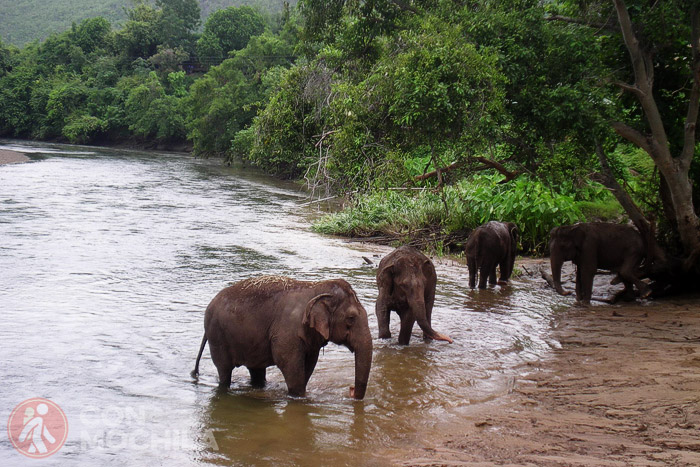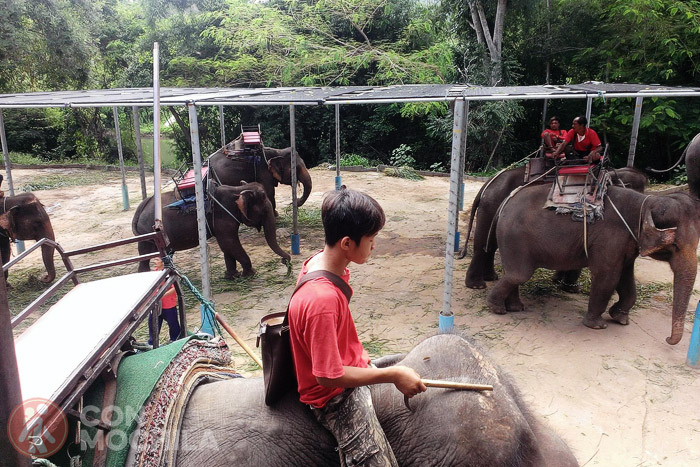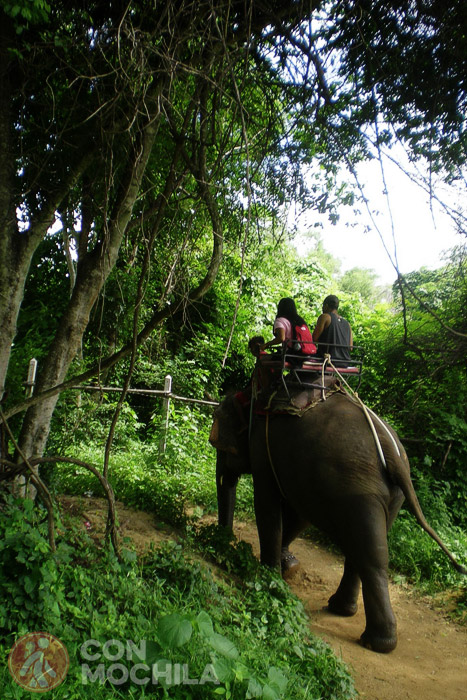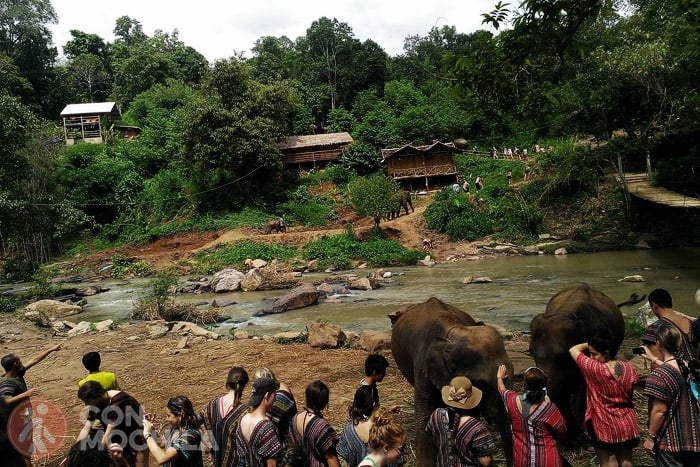Sustainable tourism and particularly responsible tourism toward animals concerned us and it’s something we like to talk about every now and then in our blog. It’s been a while since we wrote that article called “Tourist attractions and animal abuse: be informed and don’t be accomplice“, a post well accepted which had a lot of visits and acceptance and made us realize that you, the readers, are also concerned about animal welfare.
That’s why, when Flori wrote us a few months ago, explaining that she was going to do a research about responsible tourism and elephants in Thailand, we decided to help her a little in exchange of knowing about her experience and her conclusions. I was lucky to meet her in Thailand and realize that we have a similar point of view about this situation, so I’m glad to share with you the article she wrote, but first let me introduce her to all of you:
After having worked for several years in the mass tourism industry, Flori Green decided to reconvert to sustainable tourism by studying it at HERS Libramont in Belgium. Being very much concerned by animal welfare she decided to deepen her knowledge in the field of responsible tourism towards animals by performing a 4 months internship within the Spanish ONG FAADA – Turismo Responsible con los Animales in Barcelona.
Having noticed that there is a real lack of knowledge amongst tourism professionals and tourism universities forming future professionals, regarding the harsh reality behind the use of wild animals for tourism purposes, she arrived to the conclusion that it was more than necessary to bring this information forward with the help of her graduation work.
To do that, Flori chose to analyse the influence of the responsible tourism towards animals on tourism sustainability by making a study case on the use of the elephants in the tourism industry in Thailand.
After an intensive scientifically research on this subject followed by a one month on-field case study in Thailand, the conclusion of the study came out quite clear to her: practicing responsible tourism towards animals can be fully beneficial to all parties involved (tourists, tourism professionals, local populations, etc.), and can allow them without any trace of doubt to achieve sustainable long term economic and social development as well as environmental protection.
But, do we (tourists) know what is responsible tourism about? Here you are Flori’s article with her feelings, experience and conclusions.
By Flori Green
I can clearly remember the first time I saw an elephant “face to face”. It was back in 2013, during a familiarisation trip in Sri Lanka (I was working for a travel agency in Belgium at that time).
Riding an elephant in an elephant camp or simply seeing elephants in a sanctuary or in a Natural Park are some of the most appreciated tourist activities in this country and by that time, I was already aware and touched by the suffering of the elephants used in the tourism industry.
While visiting an elephant tourist site, I recall watching them bathing. One huge elephant set aside, out of the water, swaying from side to side as if it was dancing on the rhythm of the music that could be heard from the nearby restaurant. Wow!!! The elephant was dancing! The child in me was totally amazed!
It was only this year during my internship with FAADA – Turismo Responsable Con Los Animales that I found out that bouncing from side to side is nothing but a stereotypic behaviour disorder caused by captivity, and most of the captive elephants suffer from it.
That made me realise that despite being an animal lover wishing what’s best for these beautiful beings, my lack of knowledge and naivete made me see that pachyderm as a happy dancing one rather than what it really was: an elephant in distress, showing signs of psychological trauma due to prolonged captivity.
This year, as part of my studies in Sustainable Tourism, I have decided to decipher the influence of the responsible tourism towards animals on tourism sustainability through my graduation work. Since pachyderms became very dear to my heart, I decided to restrain my research by making a case study on the use of the elephants in the tourism industry in Thailand.
After a very rich scientific research and long discussions with several specialists, I decided to go to Thailand for one month and see things with my own eyes, talk to people of different backgrounds, meet local specialists and tourism professionals… in short: make my own opinion. Thus, during the month of July 2016, I could visit 10 different elephant tourist sites of different categories such as: traditional elephant camps and elephant training centres, elephant sanctuaries, as well as rescue and rehabilitation centres.

During this trip, I could meet many tourists from all over the world. Most of them seemed to be preoccupied by the wellbeing and the welfare of the pachyderms which each of them seemed to evaluate according to his or her own level of knowledge and awareness, just like I did 3 years ago.
For example, speaking to Peter and Anna, two young American tourists from New York, right after their 15 minutes’ elephant back ride, they both seemed to have appreciated what they considered to be a good level of care and wellbeing of the animals.
None of them seemed to be worried about the heavy weight that the elephant had to carry nor had they noticed that the Mahouts (the persons controlling the elephants), were controlling them with a hook and that all the elephants had deep scares on their foreheads.
They didn’t notice either the chains around their ankles deformed by prolonged wearing, nor the fact that the Mahouts were continuously hitting them behind their ears with their feet “driving” them wherever they wanted and keep them away from the trees, as the hungry elephants were trying to reach out for food.
They were not surprised or worried for their own safety either, when their extremely young Mahout (13-15 y. o.) got off the elephant after 5 minutes of riding asking them to mount on its neck without taking any safety precautions, considering that elephants are animals that get scared and angry easily and thus became extremely dangerous.
Thousands and thousands of people are dying each year due to elephant attacks or elephants trying to save themselves of whatever appears to them as an imminent danger.
As per the chained elephants that were swaying from side to side, Peter and Anna thought naively, just like I did a while ago, that they were dancing…

This scenario repeated itself, more or less, in all of the other traditional camps that I visited during my trip. Elephants were being abused physically and psychologically, put in display to amuse the hordes of tourists and starved by the same occasion for one and unique reason: profit. At the same time, lives of tourists and Mahouts were being put in danger for the same obvious logic.
When talking to a traditional camp owner, he confessed to me that it happens quite often that angry pachyderms attack their Mahout. Perceived as an oppressor, the one who tries to dominate them through violence, denies them from roaming freely and eating whenever they are hungry, forbid them to follow their natural instincts, to mate, etc., elephants seam to hold a grudge and get their revenge whenever possible. Thus, deadly attacks happen quite often and most of them are hidden from public eyes for fear of bad publicity.
The same camp owner appeared to be fascinated by the intelligence of the pachyderms who, he says, seem to make a difference between tourists and Mahouts. Thus, he believes that the elephants can tell that tourists do not seek to dominate them, therefor, they will rarely attack voyagers directly. However, since they scare easily, elephants might start running chaotically while having tourists on their back or in their vicinity and by doing so, put their life in danger.
This year only, many such incidents could escape the vigilance of the ones concerned and made the headlines of the commercial press on the web and the curious reader can easily find them by simply Googling.

The situation is, up to a certain level, better in sanctuaries or so called “sanctuaries”, but the mentality stays somehow the same for many of the visiting tourists and thus for the welfare of the elephants. The tourists who choose to visit a sanctuary, be it genuine or not, seem to be more concerned with the wellbeing of the animals.
Unfortunately, they don’t always inform themselves deeply before choosing the place they want to visit or simply indulge into the idea that just because an elephant is not forced to give back rides, or there are no chains or a visible tool of control such as the hook, everything is fine.
Sadly, my experience in Thailand proved it all wrong. Thanks to the knowledge shared with me by different experts in this matter that I encountered in Thailand, followed by own observation, I found out that things are not always what they seem.
Many of the sanctuaries declare themselves to be “hook free” and “back ride” free. But does that really mean that they use no other painful mean of control or that the pachyderms are always treated ethically? Unfortunately, that is not always the case. I’ve been taught that when a Mahout carrying no hook keeps his fist clenched it is because he has a small stiff metal object hidden in it, used to control the elephants by sticking them whenever its caretaker considers it necessary.
More discreet that the hook, this object is not visible to the non-experienced eye of tourists, who feel assured that the animal is not physically abused. A behaviour that I could spot in a so-called sanctuary along with other practices that raised many questions as to the ethical treatment of the elephants.
First of all, all their elephants were very young (up to 25 years old). A strange situation bringing up two fundamental questions: “where are all these young elephants coming from” and, as most of them were under the age of 5, “why aren’t they with their mothers as they should be”? According to the information provided by the guide as well as on the company’s website, they were all saved.
However, I found out that this so called “sanctuary” is in fact a commercial entity holding 6 other elephant camps, all of them having mostly babies or very young elephants.
Why such young elephants? Well, simply because they attract more tourists and are easier to control. Which is exactly what I could see during my visit as well as on the many videos posted on the company’s Facebook page. The amount of tourists in these camps is extremely high, very noisy and very much “it’s all about me” specific for the “selfie tourist”. The pachyderms seam to lack value for this type of tourists unless they can take selfies and can be taken in pictures with the animal.
Here, all the Mahouts were having their fist clenched and touching the elephants whenever they wanted them to do something. The animals were controlled into being there to please tourists, who were incited to feed them a few bananas, take tons of pictures (most of them with flash, very disturbing for the elephants), touch them, caress them, briefly… be all over them. The elephants who would try to move away from tourists would be stopped by their Mahout with a discreet touch of the fist and a voice command.

Furthermore, elephants would go through the same routine repeatedly as tourists arrived: being fed a few bananas, sometimes even teased with the food by certain tourists, caressed, taken in pictures, washed, etc. again and again and again… Some of the baby elephants were even taught to perform some simple tricks such as bowing to impress the visitors.
Another thing that raised an alarm signal in this place was the fact that the elephants wanting to protect their skin from the burning sun by covering it in dust or mud, were prevented to do so. However, if any of them managed to do it or right after the mud bath tourist program, elephants were taken immediately back to the river to be rewashed by their Mahouts and thus, be all “nice and shiny” for the new coming tourists. A manoeuvre that was being done in the most discreet manner while the old tourists were moving away from the elephants.
The other two sanctuaries that I could visit were more careful with their protégés, but still allowed a whole lot of contact with the tourists.
One of those two sanctuaries seemed better organised in handling the large number of visitors, and that was reflected in the behaviour of the elephants who seemed calmer, just like the tourists around them as well as their Mahouts. However, the situation changed completely, as soon as the elephants were taken to the river to be washed by tourists, due to high level of noise caused by over excited excursionists. A
situation that one of the employees of the sanctuary confessed to be quite disturbing for the elephants who see themselves surrounded by people that they are not familiar with. The same employee declared that the Mahouts found themselves highly stressed and worried whenever tourists and elephants are at proximity as this can disturb the elephants by provoking them stress or anger becoming thus, more dangerous for each party involved.
So, the question that you might ask is: if close contact with humans is not synonym of elephant wellbeing, why do sanctuaries (real sanctuaries) allow it? The answer is more simple that we might think: no matter how good the intentions of the sanctuary are, they need to provide for their elephants, offer them shelter and medical care, etc. And the costs are very high!
Unfortunately, money doesn’t fall from the sky and sanctuaries need to attract tourists to ensure that they can continue to provide for their elephants and save new ones.
The problem is that many of the tourists ask for close contact with the animals, they want to take tons of selfies and fail to realise the impact on the wellbeing and welfare of both elephants and Mahouts.
So what is the perception of tourists visiting sanctuaries about this situation? Several tourists answered that question for me by simply stating that they wanted the close contact and the selfies more than anything and they were considered that it wasn’t disturbing the elephants as “this was for sure much better than their previous life where they were forced to carry people on their backs or perform all kind of tricks to entertain tourists”.
But is that all animal protection is about? Is that enough to reach a good level of animal wellbeing and welfare? Does that give tourists a real, genuine image of what these amazing creatures are when they are submerged by so many strangers? How far are tourists willing to go to ensure animal and why not, human protection, by the same occasion?
I will let each of you consider your position about this matter… As for me, I must confess that the most beautiful moments that I’ve lived in Thailand were when I could share quiet moments with the Mahout, learn about him and elephants from a distance, observing them quietly and simply enjoying seeing them calm or joyful, connecting with each other and just being elephants.